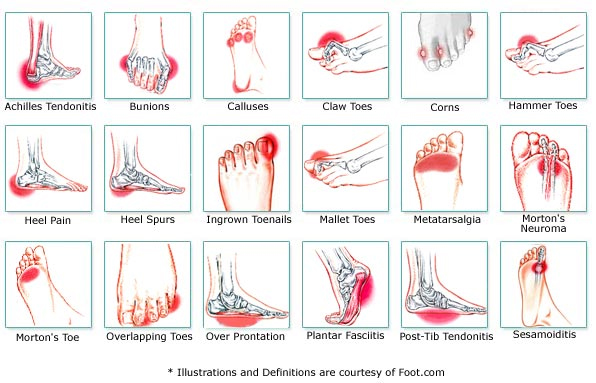Heel pain is a very common symptom that can affect anyone at nearly any age. Heel pain is difficult to ignore and can make daily activity unbearable, especially if you are on your feet all day. There are a number of conditions that can cause heel pain, each with distinct characteristics.
1. Plantar Fasciitis
Plantar Fasciitis is far the most common condition that causes heel pain. Plantar fasciitis is caused by inflammation at the under side of the heel bone where a band of connective tissue called the plantar fascia attaches.
Plantar fasciitis is characterized by pain on the bottom of the heel that is often felt upon weight bearing after rest, such as when taking your first steps in the morning or when standing up after prolonged sitting. X-ray of the heel area may reveal bone spurs, also called heel spurs. They are a common finding and are usually not the cause of the pain.
2. Achilles Tendonitis
Achilles tendonitis is inflammation due to overuse or trauma to the achilles tendon, the large cord-like tendon that attaches to the back of the heel bone. The pain is usually located at the part of the tendon that is slightly above the heel bone.
3. Bursitis
Bursitis is inflammation of a fluid-filled sac that lies between a tendon and bone. Retrocalcaneal bursitis causes pain deep in the back of the heel and is the result of inflammation of a bursa that lies beneath the Achilles tendon where it attaches to the back of the heel bone. Another type of bursitis occurs from the shoe rubbing against a bony prominence on the heel bone. This results in pain, redness, and sometimes swelling at the upper part of the back of the heel.
5. Calcaneal Apophysitis
Calcaneal apophysitis is also known as Sever’s disease, this is a condition that affects adolescents, generally age 8-14 years old.
The pain is due to stress and strain on the at the back of the heel bone, or calcaneus, which is still actively growing in adolescence. It can be brought on by tight calf muscles coupled with recent increases in activity, such as with sports.
Treatments for these 5 Types of Heel Pain
What all of these conditions have in common is that they can be caused or aggravated by overuse, abnormal foot anatomy or function, and tight muscles. The treatment plan for these types of heel pain may include :
- Rest, ice, and elevation of the affected limb
- Orthotics or heel lifts to correct anatomical problems or reduce strain on tight muscles
- Stretching Exercises
- Anti-inflammatory medications
- Physical therapy
- Night splints to stretch tight muscles
- Cortisone or other anti-inflammatory medicine injections
- Immobilization with a brace or cast
- Surgery if conservative measures fail
More Causes of Heel Pain
6. Nerve Entrapment
Nerve Entrapment: Certain nerves in the foot and ankle area are prone to impingement due to their proximity near other anatomical structures.
Impingement, or entrapment, of these nerves can result in radiation of pain to the heel area. One example is a condition called Tarsal Tunnel Syndrome, which is entrapment of a large nerve entering the foot. Possible treatments include cortisone shots, anti-inflammatory medication, or surgery.
7. Stress Fracture
A stress fracture is a small fracture within a bone that occurs from chronic repetitive stress. Athletes or anyone with recent increases in weight-bearing physical activity such as running are at risk. Osteoporosis, or decreased bone mass, can also increase the risk of stress fracture. A stress fracture is treated with casting or immobilization.
8. Bone tumors
Bone tumors are a very rare cause of heel pain. A bone tumor would be identified on an x-ray or other diagnostic imaging study. Definitive diagnosis would be made with a biopsy of the lesion.
9. Autoimmune Diseases
Heel pain can manifest as a symptom of certain autoimmune diseases such as rheumatoid arthritis, ankylosing spondylitis, and reactive arthritis.
When to See a Doctor About Heel Pain
Occasional mild heel pain may be alleviated by rest, ice, massage and stretching of the affected limb. When the pain becomes a chronic, daily problem that doesn’t go away with these measures, see a podiatrist or other health provider. Seek medical attention as soon as possible for any severe pain, redness, or swelling. These symptoms may indicate infection which is not a common cause of heel pain, but can occasionally be seen in diabetics and young children.
Sources:
Baravarian DPM, Bob. “Keys To Diagnosing And Treating Achilles Insertional Pain And Retrocalcaneal Exostosis Pain.” Podiatry Today Sep 2010 23 (9): 68-72.
Klippel, MD, John H. (Ed.), Weyand MD, PhD, Cornelia M., Wortmann, MD, Robert L. (Assoc. Eds.). “Reactive Arthritis (Reiter’s Syndrome) and Enteropathic Arthritis.” Primer on the Rheumatic Diseases, 11th ed. Atlanta: Arthritis Foundation, 1997. pp 184-189.
Klippel, MD, John H. (Ed.), Weyand MD, PhD, Cornelia M., Wortmann, MD, Robert L. (Assoc. Eds.). “Rheumatoid Arthritis.” Primer on the Rheumatic Diseases, 11th ed. Atlanta: Arthritis Foundation, 1997. p164.
Sammarco MD, James G. and Cooper MD, Paul S (Eds.), “Soft Tissue Trauma of the Hindfoot.” Foot and Ankle Manual, 2nd ed. Williams and Wilkins, 1998. 103-107.

